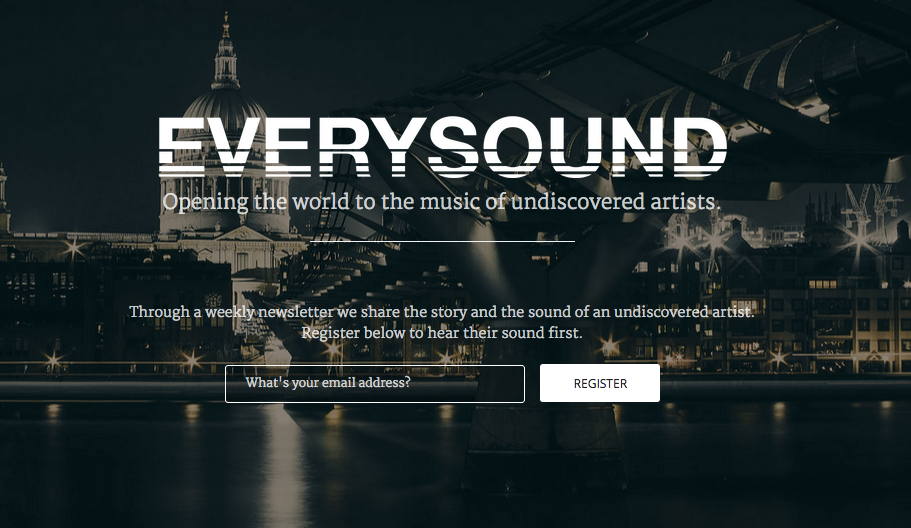Over 3 months, Ben and I started Everysound. We identified a problem, we made a logo, we built a landing page, we created a MailChimp account, we started building a social media presence and we started telling people about it.
We were gaining followers. We had subscribers. When we told people, they were interested. We spoke to artists and they wanted to be involved. “This is cool” we thought, people are interested in it.

But then it occurred to us, what actually is it?
“…Spotify for undiscovered artists”
“…YouTube for new artists”
“…we’re moneyballing A & R”
“…a human-recommended music engine”
“…a meritocratic discovery platform for better music”
“…MySpace but done better”
Each time we ‘pitched’ someone our idea, we said something different. Each time we spoke about the product we wanted to develop, the roadmap changed.
Whilst we’d identified a problem and could say what we wanted the outcomes of the solution to be, we couldn’t actually nail what it was. A streaming service, a recommendation engine, a video content site, a data play — we just didn’t know.
And we couldn’t work it out. “Talk to your users” I thought, but we didn’t really have any. It is hard, well impossible, to get users when you don’t really know what it is. Whilst we could talk to young artists in order to understand their problems, it didn’t directly point to an easy-to-build solution. There needs to be founder conviction from the product sense.
Then we slowed down. At the idea stage it is fun; ideating concepts, coming up with hundreds of different names, taglines and logos. But then the work begins and you have to pick one and run with it. I don’t think we were fully prepared to run with it. We loved the concept, and could see a real opportunity to change an industry, but because we didn’t know what it was our enthusiasm was quickly diminished.
But it is not all bad.
This was the first side-project for both Ben and I. A big part of our motive was just working together and putting an idea out in the wild. We acheived both of those things. We also learned a bunch of things a long the way.
Lessons learned
- Product vision comes from the founders. Talking to users will help you improve the product, get it from A to Z. But to get it to A, you need a strong vision of what it is. Without this, you won’t be able to build a small user base to start with.
- Don’t like the idea of a starting a startup more than your idea for a startup.
- Nail a 30 second pitch and tweak it over time. (note: the words can change, but the substance should be mostly the same. If this isn’t the case, then you don’t know what it is well enough.)
- Having an idea doesn’t mean you are the right person to bring it to life. When you evaluate an idea, you should also be evaluating your suitability at pulling it off. If it is related to a complex, multi-layered and integrated industry, do you know or can you get to know someone who can help you understand it better? Roberto Bonanzinga describes this as the DNA Matching test.
- Coming up with the perfect name is hard.
- Coming up with the perfect logo is hard.
- Coming up with the perfect tagline or mission is really hard.
- Realise that 5, 6 and 7 are almost impossible at such an early stage. Favour choosing one and moving on to the next thing then focusing too much on any of these. Your startup won’t fail because the name, logo or tagline was not perfect.
- Lean startup is a useful concept, but it is also limited. An MVP needs to convey at least some of the value of what you’ll be creating. Landing pages and newsletter can’t always do this. Sometimes you’ll need to roll your sleeves up and built it.
- It is hard to build a side-project. You will always have less time than you think you will.
- Don’t worry about over-selling the idea. The people you want to speak to will understand you are at the early part of a long process. The people who don’t understand that, are not the early adopters you want the early feedback from.
- The idea stage is always the most exciting. Sleep on ideas and see if they are as exciting in the morning.
- The value is in the follow-though. Focus on being a follow-through person rather than an ideas person.
- Don’t jump from idea to idea. It is easy to keep suggesting and listing things you could do. It is more effective to pick one thing that is really important to do, talk that through, and develop key actions to go an achieve. See Scott Belsky’s talk Making Ideas Happen to avoid the idea-to-idea problem.
There is a lot to take away from Everysound and we’ll endeavour to put these learnings into our next idea.
Ultimately, we feel the process of launching Everysound has taken us forward. As an entrepreneur, at some point you have to say “fuck it” and take that leap of faith. We have done that and whilst it wasn’t a success, we are no longer so scared of the next jump and feel much more prepared for when that may be. On to the next one.
If anyone has shared a similar experience, we’d love to hear what lessons you learned or any advice you could give - we’re @stevanpopo and @bencdavis on Twitter.
p.s. Ben is already putting these lessons into something new. If you like to read books, you should check out Papermark.
Related posts:
- Walks vs Sprints - Where I discuss the ebb and flow of developing a new product.